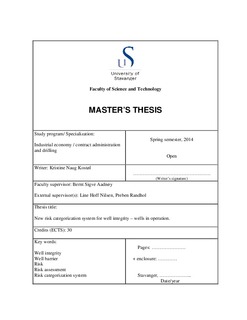| dc.contributor.author | Kostøl, Kristine | |
| dc.date.accessioned | 2014-10-07T13:19:50Z | |
| dc.date.available | 2014-10-07T13:19:50Z | |
| dc.date.issued | 2014-06-16 | |
| dc.identifier.uri | http://hdl.handle.net/11250/223322 | |
| dc.description | Master's thesis in Industrial economics | nb_NO |
| dc.description.abstract | Well integrity is defined as:” the application of technical, operational and organizational solutions to reduce risk of uncontrolled release of formation fluids, throughout the life cycle of a well” (1).
An uncontrolled release of hydrocarbons to the surroundings may have devastating consequences involving loss of lives, environmental damage and huge economic impact. Therefore it is extremely important that the integrity is assured at all times. A two barrier criterion is required for all the wells on the Norwegian Continental Shelf in contact with an over pressured reservoir. The dual barrier envelopes shall reduce the risk of a hydrocarbon leak to the surroundings.
The highest risk for a major accident is experienced and considered to be during drilling and well operations, and not in the production / injection phase. However, history clearly shows the risk for a blowout / well release from wells that have been in production with the Bravo and Snorre A blowouts as serious examples. With today’s extended well lifetime, the integrity in the operational phase needs increased focus as the failure rate in old wells may become more frequent.
To have overview and control of the wells in operation a categorization system for well integrity was developed in Norwegian Oil and Gas Recommended Guidelines 117, chapter 4. This system is based on the condition and number of barriers in a well, thus it is in direct association with the probability of a leak to the surroundings. Operators on the Norwegian Continental Shelf have used this system as a basis when developing their own risk status codes, but there is a common interest for a categorization system that captures the total risk picture in a better way. By only looking into the physical barrier status of the wells, an important part of the overall risk is left out. The leak is not quantified (above the acceptance criteria), if it is serious or insignificant, and the potential consequences of the leak are not taken into consideration. Statoil is one of the operators realizing the need for a risk status code that includes these aspects. They have experienced difficulties when ranking and prioritizing wells outside the dual barrier criterion, and are interested in a system for further differentiation of the most critical wells. In this way the most risky wells can be prioritized first and evaluated in a more detailed risk assessment.
The main scope of this thesis is suggesting a categorization system describing the overall risk in a better way than the existing. This is done by implementing the potential consequences as a second dimension in addition to the barrier status. Risk can be defined as the combination of the probability of an event and the associated consequences, and a status including both these elements will give a better description of the overall risk. As the main task is producing a new classification system for the consequences, this will be the part emphasized in the suggested models. In combination with the existing barrier status codes (based on the color codes in Norwegian Oil and Gas Recommended Guidelines 117 for Well Integrity) this gives a status which represents a more complete risk picture.
This thesis suggests several systems for consequence categorization, and the one most representative is presented as model 3. By testing it on 5 field cases, the results clearly show why the new system gives a better description of the overall risk contra the existing.
| nb_NO |
| dc.language.iso | eng | nb_NO |
| dc.publisher | University of Stavanger, Norway | nb_NO |
| dc.relation.ispartofseries | Masteroppgave/UIS-TN-IØRP/2014; | |
| dc.rights | Attribution 3.0 Norway | * |
| dc.rights.uri | http://creativecommons.org/licenses/by/3.0/no/ | * |
| dc.subject | industriell økonomi | nb_NO |
| dc.subject | well integrity | nb_NO |
| dc.subject | well barrier | nb_NO |
| dc.subject | risk | nb_NO |
| dc.subject | risiko | nb_NO |
| dc.subject | risk categorization system | nb_NO |
| dc.subject | brønnteknologi | nb_NO |
| dc.title | New risk categorization system for well integrity - wells in operation | nb_NO |
| dc.type | Master thesis | nb_NO |
| dc.subject.nsi | VDP::Social science: 200::Economics: 210 | nb_NO |

